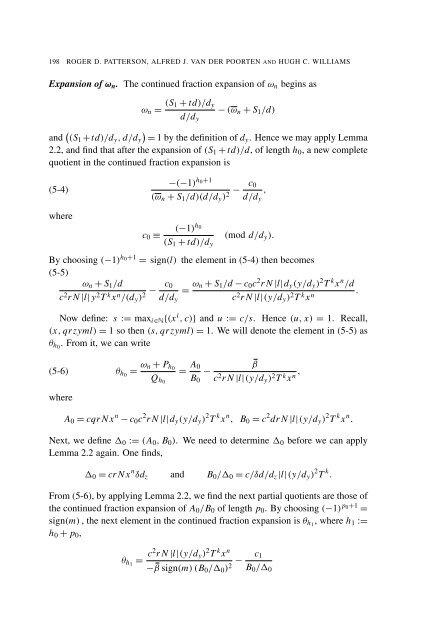Characterization of a generalized Shanks sequence - Department of ...
Characterization of a generalized Shanks sequence - Department of ...
Characterization of a generalized Shanks sequence - Department of ...
You also want an ePaper? Increase the reach of your titles
YUMPU automatically turns print PDFs into web optimized ePapers that Google loves.
198 ROGER D. PATTERSON, ALFRED J. VAN DER POORTEN AND HUGH C. WILLIAMS<br />
Expansion <strong>of</strong> ωn. The continued fraction expansion <strong>of</strong> ωn begins as<br />
ωn = (S1 + td)/dy<br />
d/dy<br />
− (ωn + S1/d)<br />
and <br />
(S1 +td)/dy, d/dy = 1 by the definition <strong>of</strong> dy. Hence we may apply Lemma<br />
2.2, and find that after the expansion <strong>of</strong> (S1 + td)/d, <strong>of</strong> length h0, a new complete<br />
quotient in the continued fraction expansion is<br />
(5-4)<br />
where<br />
−(−1) h0+1<br />
c0<br />
− ,<br />
(ωn + S1/d)(d/dy) 2 d/dy<br />
c0 ≡<br />
(−1)h0<br />
(S1 + td)/dy<br />
(mod d/dy).<br />
By choosing (−1) h0+1 = sign(l) the element in (5-4) then becomes<br />
(5-5)<br />
ωn + S1/d<br />
c2r N |l| y2T kx n c0<br />
− =<br />
/(dy) 2 d/dy<br />
ωn + S1/d − c0c2r N |l|dy(y/dy) 2T kx n /d<br />
c2r N |l|(y/dy) 2T kx n<br />
.<br />
Now define: s := maxi∈{(x i , c)} and u := c/s. Hence (u, x) = 1. Recall,<br />
(x, qrzyml) = 1 so then (s, qrzyml) = 1. We will denote the element in (5-5) as<br />
. From it, we can write<br />
θh0<br />
(5-6) θh0 = ωn + Ph0<br />
where<br />
Qh0<br />
= A0<br />
−<br />
B0<br />
β<br />
c2r N |l|(y/dy) 2T k ,<br />
xn A0 = cqr N x n − c0c 2 r N |l|dy(y/dy) 2 T k x n , B0 = c 2 dr N |l|(y/dy) 2 T k x n .<br />
Next, we define 0 := (A0, B0). We need to determine 0 before we can apply<br />
Lemma 2.2 again. One finds,<br />
0 = cr N x n δdz and B0/0 = c/δd/dz |l|(y/dy) 2 T k .<br />
From (5-6), by applying Lemma 2.2, we find the next partial quotients are those <strong>of</strong><br />
the continued fraction expansion <strong>of</strong> A0/B0 <strong>of</strong> length p0. By choosing (−1) p0+1 =<br />
sign(m) , the next element in the continued fraction expansion is θh1 , where h1 :=<br />
h0 + p0,<br />
θh1 = c2r N |l|(y/dy) 2T kx n<br />
c1<br />
−<br />
−β sign(m) (B0/0) 2 B0/0

















